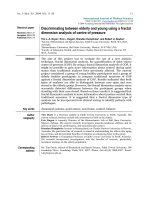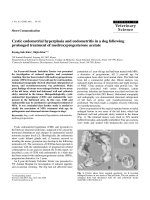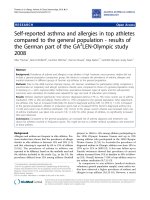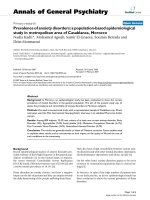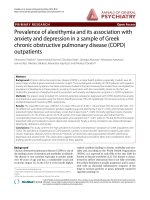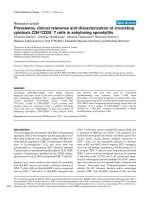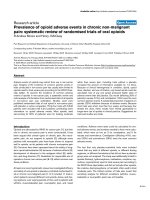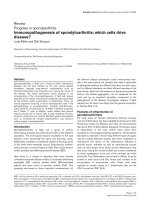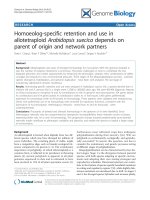Báo cáo y học: "Prevalence of alexithymia and its association with anxiety and depression in a sample of Greek chronic obstructive pulmonary disease (COPD) outpatients" pptx
Bạn đang xem bản rút gọn của tài liệu. Xem và tải ngay bản đầy đủ của tài liệu tại đây (578.24 KB, 7 trang )
Tselebis et al. Annals of General Psychiatry 2010, 9:16
/>Open Access
PRIMARY RESEARCH
BioMed Central
© 2010 Tselebis et al; licensee BioMed Central Ltd. This is an Open Access article distributed under the terms of the Creative Commons
Attribution License ( which permits unrestricted use, distribution, and reproduction in
any medium, provided the original work is properly cited.
Primary research
Prevalence of alexithymia and its association with
anxiety and depression in a sample of Greek
chronic obstructive pulmonary disease (COPD)
outpatients
Athanasios Tselebis*
1
, Epaminondas Kosmas
2
, Dionisios Bratis
1
, Georgios Moussas
1
, Athanasios Karkanias
1
,
Ioannis Ilias
3
, Nikolaos Siafakas
4
, Alexandros Vgontzas
5
and Nikolaos Tzanakis
4,6
Abstract
Background: Chronic obstructive pulmonary disease (COPD) is a major health problem, especially in adults over 40
years of age, and has a great social and economic impact. The psychological morbidity of COPD patients with regard to
anxiety and depressive symptoms has been extensively studied in the past. However, few studies have investigated the
prevalence of alexithymia in these patients, as well as its association with this comorbidity. Based on this fact, we
studied the prevalence of alexithymia and its association with anxiety and depressive symptoms in COPD outpatients.
Methods: The present study included 167, randomly selected, outpatients diagnosed with COPD. Alexithymia, anxiety
and depression were assessed using the Toronto Alexithymia Scale (TAS-20), Spielberger Trait Anxiety Inventory (STAI),
and Beck Depression Inventory (BDI), respectively.
Results: The mean BDI score was 12.88 (SD: 7.7), mean STAI score 41.8 (SD: 11.0) and mean TAS-20 score 48.2 (SD: 11.5).
No differences were observed between genders regarding age and alexithymia (t test P > 0.05), while female patients
presented higher depression and trait anxiety scores than males (t test P < 0.05). Clinically significant levels of anxiety
were present in 37.1% of men, and in 45.7% of women. The mean depression score was also higher than the
corresponding mean score in the general population (one-sample t test P < 0.01), while 27.7% and 30.5% of the sample
presented mild and moderate to severe depression, respectively. Finally, a strong correlation was observed between
alexithymia, depression and anxiety.
Conclusions: This study confirms the high prevalence of anxiety and depression symptoms in Greek outpatients with
COPD. The prevalence of alexithymia in COPD patients, contrary to what has been observed in patients with other
chronic respiratory diseases, seem to be lower. However, we observed a strong association between alexithymia,
depression and anxiety levels. This observation suggests that alexithymia should be taken into consideration when
drafting specific psychotherapeutic interventions for these patients.
Background
Chronic obstructive pulmonary disease (COPD) is one of
the leading causes of mortality and morbidity worldwide.
The disease is very common especially in smoker adults
over 40 years of age and has a considerable social and
economic impact [1]. In the USA it is the fourth highest
ranked condition leading to chronic morbidity and mor-
tality and, according to the World Health Organization
(WHO), it is expected to rank fifth in the year 2020 for
burden of disease worldwide [2,3]. The disease is charac-
terised by airflow obstruction that is not fully reversible;
this airflow limitation is usually progressive and is associ-
ated with an abnormal inflammatory response of the
lungs to noxious particles or gases, primarily caused by
cigarette smoking [1].
* Correspondence:
1
Psychiatric Department, Sotiria General Hospital of Chest Diseases, Athens,
Greece
Full list of author information is available at the end of the article
Tselebis et al. Annals of General Psychiatry 2010, 9:16
/>Page 2 of 7
With regard to Greece, studies from the 1980s pointed
to this disease being a public health problem [4]. At the
same time, COPD's effect on the psychological status of
patients was recognised [5].
However, the relevant psychological status studies have
mainly been focused on the prevalence of anxiety [6-10]
and depression, which often appear together in these
patients [11-15]. The prevalence of depression among
outpatients with COPD is substantially greater than life-
time rates in the general population (ranging between
10% and 42% in the former, compared to approximately
5% in the latter). Correspondingly, the prevalence of anxi-
ety varies from 10% to 19% [15], a percentage that is
higher than the 15% that is reported in the general popu-
lation [16,17]. Regarding patients who have recently
recovered from an acute exacerbation of COPD, the prev-
alence of depression is even higher and ranges between
19.4% and 50% [15]. The same is true concerning anxiety,
with the percentage ranges between 9.3% and 58% [15].
Both depression and anxiety are significantly associated
with decreased functional status and worse health status
when compared to those of patients without psychologi-
cal symptoms, even after controlling for the effects of
overall health status [13,17-19]. Higher predominance of
depression and anxiety was observed in patients with
COPD compared to patients that suffered from other
chronic respiratory disorders, such as bronchial asthma
and tuberculosis [17].
Alexithymia indicates 'lack of words for emotions' [20].
This term was first used in the 1970s, when Nemiah and
Sifneos, evaluating psychiatric interviews of patients with
classic psychosomatic ailments, found that most of these
patients had great difficulty in describing their feelings
verbally as well as limited capacity to fantasise [21]. Sif-
neos [20], in an effort to describe these symptoms under
a coherent term coined the phrase alexithymia (loosely
based on ancient Greek, from αλέξε = deflect + θυμικο =
the emotional moiety of the soul); thus it literally implies
a deflection of emotions. In general, subjects with alexi-
thymia usually complain of somatic symptoms, regardless
of their somatic ailment. At the same time they have great
difficulty in recognising and describing their emotions
[20-22]. Although the role of alexithymia and its associa-
tion with levels of anxiety and depression has already
been recognised in other respiratory diseases, such as
bronchial asthma [23], few studies have investigated the
possibility that alexithymia may also be prevalent in
patients suffering from COPD [24-26].
Taking into account the high prevalence of anxiety and
depression in patients with COPD [15], as well the
reported associations among depression, anxiety, somatic
symptoms and alexithymia [27], we studied the preva-
lence of alexithymia and its association with anxiety and
depression in a sample of Greek COPD outpatients.
Methods
Sample
From the outpatients list of scheduled appointments at
our hospital's clinics (among the largest respiratory dis-
ease hospitals in Europe) we selected those to be included
in the study with randomisation using a Microsoft Excel
(Microsoft, Redmond, WA, USA) algorithm (167 COPD
outpatients). No patient refused to participate in the
study. Subjects over the age of 80 years and patients diag-
nosed with other major somatic disorders (such as heart
failure, myocardial infarction, cerebrovascular disease,
cancer, or severe orthopaedic disorders) or major mental
disorders (such as schizophrenia or sentimental disorder)
were excluded from the study. The relevant information
was obtained from the subjects' medical history and med-
ical record. Age, gender, family status and education years
were noted.
Physical measures
In order to determine the COPD severity of our sample, a
spirometric evaluation before and after bronchodilation
(200 μg salbutamol) was performed. We followed the
Global Initiative for Chronic Obstructive Lung Disease
(GOLD) diagnostic criteria, which classify COPD sever-
ity (in relation to forced expiratory volume in 1 s (FEV
1
)
percentage of predicted) into four stages. Stage I (mild
COPD): FEV
1
> 80% predicted; stage II (moderate
COPD): FEV
1
50% to 80% predicted; stage III (severe
COPD): FEV
1
30% to 50% predicted; and stage IV (very
severe COPD): FEV
1
< 30% predicted [3].
Psychological measures
Depression was assessed with the Beck Depression
Inventory (BDI) [28], which includes 21 items graded
from 0 to 3. A high total score in the questionnaire corre-
sponds to the presence of elevated depressive symptoma-
tology [16,17,23,29]. The inventory has been standardised
and used in Greek population. The inner coherence reli-
ability (α = 0.84) is high and the retest reliability ranges
from 0.48 to 0.86 for clinical groups and 0.60 to 0.90 for
non-clinical populations. Its validity in relation to an
external criterion for depression (that is, a clinical diag-
nosis) is considered to be satisfactory [30].
Anxiety was assessed with the Spielberger State Trait
Anxiety Inventory (STAI), a widely used anxiety rating
scale [31]. It consists of 40 items, each graded from 1 to 4.
The scale differentiates anxiety into (a) anxiety caused by
a specific condition (state subscale) and (b) anxiety as a
more permanent characteristic of personality (trait sub-
scale). The Greek validation of the trait subscale was used
in our study, which is considered as having a high inner
coherence reliability (α = 0.89) and validity compared to
clinical diagnosis [32,33].
Tselebis et al. Annals of General Psychiatry 2010, 9:16
/>Page 3 of 7
Alexithymia was assessed with the Toronto Alexithy-
mia Scale (TAS-20), which includes 20 items, graded
from 1 to 5. A high score (> 60) on the scale is consistent
with increased presence of alexithymic characteristics
[34]. The TAS-20 has been adapted into the Greek lan-
guage and its reliability is considered to be satisfactory (α
= 0.80) [35].
Before replying to the questionnaires used in this study,
all the subjects were evaluated by two clinical psycholo-
gists in 60 min person-to-person sessions.
Statistical analysis was performed with analysis of vari-
ance (ANOVA) and Tukey's post hoc tests, Student t test
and stepwise multiple linear regression. Statistical signifi-
cance was set at P < 0.05 (corrected where applicable).
The hospital ethics committee approved the study and
all participants provided written informed consent. No
financial support was necessary.
Results
The sample included 132 men and 35 women. The mean
age of the participants was 65.5 ± 8.2 (men: 65.4 ± 8.1 and
women 65.7 ± 8.5), while the mean FEV
1
percentage of
predicted was 41.5 ± 18.7 (Table 1). There were no differ-
ences between genders, regarding age, years of education,
and FEV
1
percentage of predicted (ANOVA P > 0.05,
Table 1). The family status of the study's subjects (77.7%
were married, 4.6% were single, 7.7% were widowed and
10% were divorced) was not found to be associated with
the studied parameters (one-way ANOVA P > 0.005).
With regard to the severity of COPD according to the
GOLD classification scheme, 10 patients had mild dis-
ease, 30 moderate disease, 75 severe disease and 52 were
at a very severe stage of the disease.
Mean BDI score was 12.88 ± 7.7, mean STAI score was
41.8 ± 11.0 and mean TAS-20 score was 48.2 ± 11.5. No
differences were observed between genders, regarding
age and alexithymia (TAS-20) (ANOVA P > 0.05, Table
2), while female patients presented higher depression
(BDI) and trait anxiety (STAI) scores than males
(ANOVA P < 0.05, Table 2).
Patients with COPD presented the same mean alexithy-
mia score (48.2) as the general population's mean score
(49.5) [35] (one-sample t test P > 0.05). However, 12% of
our sample presented with a score > 60 (Table 3).
Men presented higher mean trait anxiety levels
(ANOVA P < 0.01) than the corresponding level (34.54)
in the general Greek male population [32]. The same was
also observed in women COPD patients compared to the
mean corresponding score (37.47) in the general Greek
population of women (one-sample t test P < 0.01) [29].
Clinically significant levels of anxiety (score ≥ 44 for men
and ≥ 46 for women) were present in 37.1% of men, and
in 45.7% of women. The mean depression score was also
higher than the corresponding mean score in the general
population (5.86 one-sample t test P < 0.01) [30], while
24% and 35.3% of the sample presented mild (BDI score
10 to 14) and moderate to severe (BDI score ≥ 15) depres-
sion, respectively (Table 3).
Mean FEV
1
percentage of predicted, age and years of
education showed no correlation with alexithymia, anxi-
ety or depression score, while strong positive correlations
were noted with alexithymia, anxiety and depression
(Table 4).
To further assess factors that influence the depression
score, we used stepwise multiple regression (Table 5).
The trait anxiety score was responsible for 50.9% of varia-
tion in depression (F1
,165
= 170.74, P < 0.001) and the
alexithymia score for an additional 6.3% (F1
,164
= 24.06, P
< 0.01).
Discussion
The present study confirms the presence of a higher pro-
portion of anxiety (approximately 37.1% for male and
45.7% for female) and depression (approximately 35.3%)
Table 1: Demographics and baseline characteristics.
Characteristic Value
Male/female 132/35
Age, years (± SD)
Male 65 ± 8
Female 66 ± 9
Education, years (± SD)
Male 11 ± 4
Female 11 ± 5
FEV
1
(percentage of
predicted) (± SD)
Male 41 ± 19
Female 46 ± 17
Severity (GOLD)
Mild/moderate/severe/very
severe
10/30/75/52
FEV
1
= forced expiratory volume in 1 s; GOLD = Global Initiative
for Chronic Obstructive Lung Disease.
Tselebis et al. Annals of General Psychiatry 2010, 9:16
/>Page 4 of 7
in Greek outpatients with COPD than those in the gen-
eral population. However, the lack of a control group may
limit the generalisability of these results. The female pop-
ulation with COPD is differentiated from males by higher
levels of anxiety and depressive symptoms. These find-
ings are in accordance with previous studies that indi-
cated a higher prevalence of overall anxiety and
depressive symptoms among women with COPD [15,36].
Independently of gender, there are many mechanisms
that could be involved in this comorbidity. Patients with
COPD have poor physical functioning, a condition which
has been shown to be related to higher rate of psycholog-
ical morbidity [36]. The high levels of anxiety and depres-
sive symptoms are possibly the result of pressure from
social factors, as well as from coping with daily living.
Many of these patients have had to limit their daily activi-
ties due to their lung disease. They frequently have to
change jobs or retire early. Their social interactions are
also adversely affected because they cannot maintain
pace with their peers [37]. In addition, patients with
COPD soon realise that his/her disease is irreversible and
progressive [14,37]. Furthermore, the hypoxic nature of
the disease and dyspnoea may lead to increased distress
[36,37].
However, an impressive finding of our study was that
anxiety and depression were not correlated with COPD
severity (as determined by FEV
1
percentage of predicted).
In a previous study [38] it was reported that dyspnoea
ratings were influenced by anxiety and depressive symp-
toms, whereas the physiological state (including FEV
1
percentage of predicted) scarcely influenced the anxiety
and depressive symptomatology. Although further stud-
ies are required in order to explain these findings, it is
possible that patients construe disease seriousness sub-
jectively, which contributes to the development of the
levels of anxiety and depressive symptoms.
The prevalence of alexithymia in COPD patients, con-
trary to what has been observed in patients with other
chronic respiratory diseases, seems to be lower. However,
a positive correlation was observed between alexithymia,
anxiety and depressive symptoms. Previous studies based
on both clinical and healthy populations have reported a
connection between depressive symptomatology and
alexithymia, and it is well known that patients with
depressive disorders are prone to experiencing alexithy-
mic features [39,40]. Additionally, alexithymic features
have been related to higher levels of anxiety [41]. Due to
the limitations of our study, we cannot answer the ques-
tion of whether alexithymia leads to depressive and anxi-
ety symptoms or depression and anxiety symptoms lead
to alexithymia.
Table 2: Mean (± SD) scores for Beck Depression Inventory
(BDI), Spielberger Trait Anxiety Inventory (STAI) and
Toronto Alexithymia Scale (TAS-20).
Category Value
Depression
Male (N = 132) 12.2 ± 7.6
Female (N = 35) 15.3 ± 7.9
Total (N = 167) 12.9 ± 7.7
Anxiety
Male (N = 132) 41.1 ± 10.4
Female (N = 35) 44.7 ± 10.6
Total (N = 167) 41.8 ± 10.5
Alexithymia
Male (N = 132) 48.0 ± 11.2
Female (N = 35) 49.2 ± 12.8
Total (N = 167) 48.2 ± 11.2
Females had higher trait anxiety and depression scores than males (t
test P < 0.05, for all comparisons).
Table 3: Prevalence of anxiety, alexithymia and depressive symptoms in relation to gender.
Anxiety (STAI) Alexithymia (TAS-20) Mild depression (BDI
10-14)
Moderate to severe
depression (BDI ≥ 15)
Male 37.1% 10.6% 25% 30.3%
Female 45.7% 17.1% 20% 54.3%
Total 38.3% 12% 24% 35.3%
BDI = Beck Depression Inventory; STAI = Spielberger Trait Anxiety Inventory; TAS-20 = Toronto Alexithymia Scale.
Tselebis et al. Annals of General Psychiatry 2010, 9:16
/>Page 5 of 7
Compared with other psychosomatic and somatic dis-
eases, such as bronchial asthma, the prevalence of alexi-
thymia in COPD is lower. Furthermore, alexithymia may
be related to recurrent very severe asthma exacerbations
in asthmatics [42-44].
We did not study possible associations of COPD exac-
erbations with any of the other parameters studied. Thus,
although we cannot support a similar hypothesis for
COPD exacerbations, we believe that the correlations
that were seen among alexithymia, depression and anxi-
ety levels should be taken into consideration when draft-
ing psychotherapeutic interventions (as a part of a
pulmonary rehabilitation program) for these patients
[45]. This is more pertinent in those patients with overall
alexithymic characteristics (who often fail to recognise
their underlying psychological malaise due to a lack of
capacity for mental representation of emotions) [46,47].
These deficiencies may cause an inability to regulate
emotions and affect and, therefore, may lead to increased
somatisation and attenuated capacity to recognise the
Table 4: Correlation between forced expiratory volume in 1 s (FEV
1
) percentage of predicted, depression, anxiety and
alexithymia.
FEV1 percentage of predicted
BDI STAI
BDI (depression) Pearson correlation 0.085
Significance (two-tailed) 0.424
N167
STAI (anxiety) Pearson correlation 0.068 0.805*
Significance (two-tailed) 0.523 0.000
N 167 167
TAS-20 (alexithymia) Pearson correlation -0.026 0.510* 0.392*
Significance (two-tailed) 0.809 0.000 0.000
N 167 167 167
Significant values in bold.
*Pearson correlation P < 0.01.
BDI = Beck Depression Inventory; STAI = Spielberger Trait Anxiety Inventory; TAS-20 = Toronto Alexithymia Scale.
Table 5: Stepwise multiple regression (only statistically significant variables are included)*.
Variable Multiple R B Standard
error
β t Significance
STAI
(anxiety)
0.713 0.445 0.041 0.606 10.908 0.000
TAS-20
(alexithymia)
0.756 0.182 0.037 0.273 4.905 0.000
Dependent variable: BDI (depression).
*The following variables were eliminated: age, gender, education years and FEV
1
percentage of predicted.
BDI = Beck Depression Inventory; FEV
1
= forced expiratory volume in 1 s; STAI = Spielberger Trait Anxiety Inventory; TAS-20 = Toronto
Alexithymia Scale.
Tselebis et al. Annals of General Psychiatry 2010, 9:16
/>Page 6 of 7
underlying depressive symptoms or anxiety (and lack
thereof of therapeutic intervention) [44,47]. Furthermore,
subjects with high anxiety and depressive symptoms and
concomitant alexithymia most probably have difficulty in
verbally expressing their symptoms [22]. In alexithymia,
by definition, the difficulty in expressing psychological
symptoms as such leads to their expression as somatic
(often atypical) symptoms [22]. The latter may distract
clinicians and make them miss the psychological compo-
nent that lies at the root of the problem. Given this, the
possible presence of alexithymia should be taken into
consideration when planning specialised psychothera-
peutic interventions within respiratory rehabilitation
programs.
Additionally, patients with severe depression and anxi-
ety are less likely to be compliant to treatment plans and
more likely to be hospitalised [48]. Therefore, compre-
hensive programs should incorporate individualised
depression and anxiety management techniques.
Finally, this study does have some limitations. First is
the lack of a control group; second, we did not study pos-
sible associations of COPD exacerbations with any of the
other parameters studied. These limitations should be
taken into consideration in further work.
Conclusions
This study confirms the high prevalence of anxiety and
depression symptoms in Greek outpatients with COPD, a
finding that is in accordance with relative studies world-
wide. Additionally, our results are in agreement with
other studies, which concluded that women have more
psychological comorbidity [49-55].
In our study and in the most previous studies of
patients with COPD, FEV
1
percentage of predicted
appeared to have an unfavourable effect, being a predic-
tor of anxiety and depression in [50].
The prevalence of alexithymia in COPD patients, con-
trary to what has been observed in patients with other
chronic respiratory diseases, seems to be lower. However,
we observed a strong correlation between alexithymia,
depression and anxiety levels, a finding suggesting that
this comorbidity should be taken into consideration when
drafting psychotherapeutic programs for these patients
Competing interests
The authors declare that they have no competing interests.
Authors' contributions
AT conceived the paper, designed the study, performed the psychological
measures, collected data, carried out the statistical analysis and drafted the
paper; EK performed the physical measures, carried out the statistical analysis
and helped draft the paper; DB performed the psychological measures, col-
lected data, gave suggestions for the concept of alexithymia and helped draft
the paper; GM and AK helped draft the paper; II carried out the statistical analy-
sis and helped draft the paper; NS and AV supervised the study; NT carried out
the statistical analysis, helped draft the paper and supervised the study. All
authors read and approved the final manuscript.
Author Details
1
Psychiatric Department, Sotiria General Hospital of Chest Diseases, Athens,
Greece,
2
Pulmonary Rehabilitation Centre, Sotiria General Hospital of Chest
Diseases, Athens, Greece,
3
Endocrine Department, Elena Venizelou Hospital,
Athens, Greece,
4
Department of Thoracic Medicine, University of Crete,
Medical School, Heraklion, Greece,
5
Psychiatric Department, University of
Crete, Medical School, Heraklion, Greece and
6
Departement of Social
Medicine, Laboratory of Epidemiology, University of Crete, Medical School,
Heraklion, Greece
References
1. Nascimento OA, Camelier A, Rosa FW, Menezes AMB, Pérez-Padilla Jardim
RJR, Latin American Project for the Investigation of Obstructive Lung
Disease (PLATINO) Group: Chronic obstructive pulmonary disease is
underdiagnosed and undertreated in São Paulo (Brazil). Results of the
PLATINO Study. Braz J Med Biol Res 2007, 40:887-895.
2. Rabe KF, Hurd S, Anzueto A, Barnes PJ, Buist SA, Calverley P, Fukuchi Y,
Jenkins C, Rodriguez-Roisin R, van Weel C, Zielinski J: Global strategy for
the diagnosis, management, and prevention of chronic obstructive
pulmonary disease: GOLD executive summary. Am J Respir Crit Care Med
2007, 176:527-528.
3. Global Strategy for the Diagnosis, Management and Prevention of
COPD. Global Initiative for Chronic Obstructive Lung Disease (GOLD)
2007 []
4. Tzanakis N, Anagnostopoulou U, Filaditaki V, Christaki P, Siafakas N:
Prevalence of COPD in Greece. Chest 2004, 125:892-900.
5. Kinsman RA, Fernandez E, Schocket M, Dirks JF, Covino NA:
Multidimensional analysis of the symptoms of chronic bronchitis and
emphysema. J Behav Med 1983, 6:339-357.
6. Yellowlees PM, Alpers JH, Bowden JJ, Bryant GD, Ruffin RE: Psychiatric
morbidity in patients with chronic airflow obstruction. Med J Aust 1987,
146:305-307.
7. Wittchen HU, Zhao S, Kessler RC, Eaton WW: DSM III-R generalized
anxiety disorder in the National Comorbidity Survey. Arch Gen
Psychiatry 1994, 51:355-364.
8. Karajgi B, Rifkin A, Doddi S, Kolli R: The prevalence of anxiety disorders in
patients with chronic obstructive pulmonary disease. Am J Psychiatry
1990, 147:200-201.
9. Zandbergen J, Bright M, Pols H, Fernandez I, de Loof C, Griez EJ: Higher
lifetime prevalence of respiratory diseases in panic disorder? Am J
Psychiatry 1991, 148:1583-1585.
10. Kvaal K, Macijauskiene J, Engedal K, Laake K: High prevalence of anxiety
symptoms in hospitalized geriatric patients. Int J Geriatr Psychiatry 2001,
16:690-693.
11. Withers NJ, Rudkin ST, White RJ: Anxiety and depression in severe
chronic obstructive pulmonary disease: the effects of pulmonary
rehabilitation. J Cardiopulm Rehabil 1999, 19:362-365.
12. Kim HF, Kunik ME, Molinari VA, Hillman SL, Lalani S, Orengo CA, Petersen
NJ, Nahas Z, Goodnight-White S: Functional impairment in COPD
patients: the impact of anxiety and depression. Psychosomatics 2000,
41:465-471.
13. Yohannes AM, Baldwin RC, Connolly MJ: Depression and anxiety in
elderly outpatients with chronic obstructive pulmonary disease:
prevalence, and validation of the BASDEC screening questionnaire. Int
J Geriatr Psychiatry 2000, 15:1090-1096.
14. Light RW, Merrill EJ, Despars JA, Gordon GH, Mutalipassi LR: Prevalence of
depression and anxiety in patients with COPD: relationship to
functional capacity. Chest
1985, 87:35-38.
15. Maurer J, Rebbapragada V, Borson S, Goldstein R, Kunik M, Yohannes AM,
Hanania NA: Anxiety and Depression in COPD. Chest 2008, 134:43S-56S.
16. Tselebis A, Gournas G, Tzitzanidou G, Panaghiotou A, Ilias I: Anxiety and
depression in Greek nursing and medical personnel. Psychol Rep 2006,
99:93-96.
Received: 30 December 2009 Accepted: 14 April 2010
Published: 14 April 2010
This article is available from: 2010 Tselebis et al; licensee BioMed Central Ltd. This is an Open Access article distributed under the terms of the Creative Commons Attribution License ( .0), which permits unrestricted use, distribution, and reproduction in any medium, provided the original work is properly cited.Annals of Genera l Psychiat ry 2010, 9:16
Tselebis et al. Annals of General Psychiatry 2010, 9:16
/>Page 7 of 7
17. Moussas G, Tselebis A, Karkanias A, Stamouli D, Ilias I, Bratis D, Vassila-Demi
K: A comparative study of anxiety and depression in patients with
bronchial asthma, chronic obstructive pulmonary disease and
tuberculosis in a general hospital of chest diseases. Ann Gen Psychiatry
2008, 7:7.
18. Felker B, Katon W, Hedrick SC, Rasmussen J, McKnight K, McDonnell MB,
Fihn SD: The association between depressive symptoms and health
status in patients with chronic pulmonary disease. Gen Hosp Psychiatry
2001, 23:56-61.
19. Cleland JA, Lee AJ, Hall S: Associations of depression and anxiety with
gender, age, health-related quality of life and symptoms in primary
care COPD patients. Fam Pract 2007, 24:217-223.
20. Sifneos PE: Short-Term Psychotherapy and Emotional Crisis Cambridge, MA,
USA: Harvard University Press; 1972.
21. Nemiah JC, Sifneos PE: Affect and fantasy in patients with
psychosomatic disorders. In Modern Trends in Psychosomatic Medicine
Volume 2. Edited by: Hill OW. London, UK: Butterworths; 1970:26-34.
22. Taylor GJ: Psychosomatic Medicine and Contemporary Psychoanalysis
Madison, CT, USA: International Universities Press; 1987.
23. Tselebis A, Moulou A, Ilias I, Bratis D: Depression, family support and
alexithymia in patients with bronchial asthma. Ann Gen Psychiatry 2005,
4:128.
24. Hynninen KM, Breitve MH, Wiborg AB, Pallesen S, Nordhus IH:
Psychological characteristics of patients with chronic obstructive
pulmonary disease: a review. J Psychosom Res 2005, 59:429-443.
25. Feiguine RJ, Johnson FA: Alexithymia and chronic respiratory disease. A
review of current research. Psychother Psychosom 1985, 43:77-89.
26. Feiguine RJ, Jones NF: Alexithymia in chronic bronchitis/emphysema:
personality characteristics and illness attitudes. Psychother Psychosom
1987, 47:95-100.
27. Honcalampi K, Hintikka J, Laukkanen E, Lehtonen J, Viinamaki H:
Alexithymia and depression. A prospective study of patients with
major depressive disorder. Psychosomatics 2001, 42:229-234.
28. Beck AT, Steer RA: Manual for the Revised Beck Depression Inventory San
Antonio, TX, USA: Psychological Corporation; 1987.
29. Tselebis A, Moulou A, Ilias I: Burnout versus depression and sense of
coherence: a study in Greek nursing staff. Nurs Health Sci 2001, 3:69-71.
30. Donias S, Demertzis I: Validation of the Beck Depression Inventory [in
Greek]. In 10th Hellenic Congress of Neurology and Psychiatry: 1983;
Thessaloniki Edited by: Varfis G. Thessaloniki, Greece: University Studio
Press; 1983:486-492.
31. Spielberger CD, Goruch RL, Lushene RE: The State-Trait Anxiety Inventory
Palo Alto, CA, USA: Consulting Psychologists Press; 1970.
32. Liakos A, Giannitsi S: Reliability and validity of the modified Greek
version of the Spielberger State-Trait Anxiety Inventory. Encephalos
1984, 21:71-76.
33. Tselebis A, Papaleftheris E, Balis E, Theotoka I, Ilias I: Smoking related to
anxiety and depression in Greek medical staff. Psychol Rep 2003,
92:529-532.
34. Bagby M, Taylor G, Parker J: The twenty-item Toronto Alexithymia Scale -
II. Convergent, discriminant and concurrent validity. J Psychosom Res
1994, 38:33-40.
35. Anagnostopoulou T, Kioseoglou G: The Toronto Alexithymia Scale - TAS
20 [in Modern Greek]. In Psychometric Tools in Greece Edited by: Stalikas
A, Triliva S, Roussi P. Athens, Greece: Ellinika Grammata; 2002:100-101.
36. Laurin C, Lavoie KL, Bacon SL, Dupuis G, Lacoste G, Cartier A, Labrecque M:
Sex differences in the prevalence of psychiatric disorders and
psychological distress in patients with COPD. Chest 2007, 132:148-155.
37. Tselebis A, Moussas G, Bratis D: Psychological intervention in a COPD
rehabilitation programme [in Modern Greek]. Pneumonologika
Themata 2006:21-23.
38. Mishima M, Oku Y, Muro S, Hirai T, Chin K, Ohi M, Nakagawa M, Fujita M,
Sato K, Shimada K, Yamaoka S, Oda Y, Asai N, Sagawa Y, Kuno K:
Relationship between dyspnoea in daily life and psycho-physiologic
state in patients with chronic obstructive pulmonary disease during
long term domiciliary oxygen therapy. Intern Med 1996, 35:453-458.
39. Honkalampi K, Saarinen P, Hintikka J, Virtanen V, Viinamaki H: Factors
associated with alexithymia in patients suffering from depression.
Psychother Psychosom 1999, 68:270-275.
40. Honkalampi K, Hintikka J, Tanskanen A, Lehtonen J, Viinamaki H:
Depression is strongly associated with alexithymia in the general
population. J Psychosom Res 2000, 48:99-104.
41. Kim HW, Rim HD, Kim JH, Lee SJ: Alexithymia and stress response
patterns among patients with depressive disorders in Korea. Psychiatry
Invest 2009, 6:13-18.
42. Schier K: Affect regulation and self- and object representations in
persons suffering from bronchial asthma. International
Psychoanalytical Association. [ />schier.asp].
43. Leschinskaya B, Valeev R, Aftanas L, Kozlov V: Psychoimmunological
facets of psychosomatic diseases: bronchial asthma vs. rheumatoid
arthritis. Ann Gen Psychiatry 2006, 5(Suppl 1):S179.
44. Serrano J, Plaza V, Sureda B, de Pablo J, Picado C, Bardagi S, Lamela J,
Sanchis J: Alexithymia: a relevant psychological variable in near-fatal
asthma. Eur Respir J 2006, 28:296-302.
45. Kavoura P, Harikiopoulou M, Dumitru S, Theodorakopoulou E, Birba G,
Lambrakis H, Bratis D, Tselebis A, Koulouris N, Alchanatis M, Roussos C,
Kosmas E: Does pulmonary rehabilitation-induced improvement in
BODE index correlate with improvements in anxiety and depression
and quality of life? Chest Meet Abstr 2009, 136:52S-h.
46. Bratis D, Tselebis A, Sikaras C, Moulou A, Giotakis K, Zoumakis E, Ilias I:
Alexithymia and its association with burnout, depression and family
support among Greek nursing staff. Hum Res Health 2009, 7:72.
47. Mattila AK, Salminen JK, Nummi T, Joukamma M: Age is strongly
associated with alexithymia in the general population. J Psychosom Res
2006, 61:629-635.
48. Mannino MD, Sidney B: The epidemiology and economics of chronic
obstructive pulmonary disease. Proc Am Thoracic Soc 2007, 4:502-506.
49. Hill K, Geist R, Goldstein RS, Lacasse Y: Anxiety and depression in end-
stage COPD. Eur Respir J 2008, 31:667-677.
50. Funk GC, Kirchheiner K, Burghuber OC, Hartl S: BODE index versus GOLD
classification for explaining anxious and depressive symptoms in
patients with COPD - a cross-sectional study. Respir Res 2009, 10:1.
51. Carrasco-Garrido P, de Miguel-Díez J, Rejas-Gutierrez J, Martín-Centeno A,
Gobartt-Vázquez E, Hernandez-Barrera V, de Miguel AG, Jimenez-Garcia R:
Characteristics of chronic obstructive pulmonary disease in Spain from
a gender perspective. BMC Pulm Med 2009, 9:2.
52. Gudmundsson G, Gislason T, Janson C, Lindberg E, Suppli UC, Brondum E,
Nieminen MM, Aine T, Hallin R, Bakke P: Depression, anxiety and health
status after hospitalisation for COPD: a multicentre study in the Nordic
countries. Respir Med 2006, 100:87-93.
53. Di Marco F, Verga M, Reggente M, Maria Casanova F, Santus P, Blasi F,
Allegra L, Centanni S: Anxiety and depression in COPD patients: the
roles of gender and disease severity. Respir Med 2006, 100:1767-1774.
54. Wagena EJ, Arrindell WA, Wouters EF, van Schayck CP: Are patients with
COPD psychologically distressed? Eur Respir J 2005, 26:242-248.
55. Dahlen I, Janson C: Anxiety and depression are related to the outcome
of emergency treatment in patients with obstructive pulmonary
disease. Chest 2002, 122:1633-1637.
doi: 10.1186/1744-859X-9-16
Cite this article as: Tselebis et al., Prevalence of alexithymia and its associa-
tion with anxiety and depression in a sample of Greek chronic obstructive
pulmonary disease (COPD) outpatients Annals of General Psychiatry 2010,
9:16
